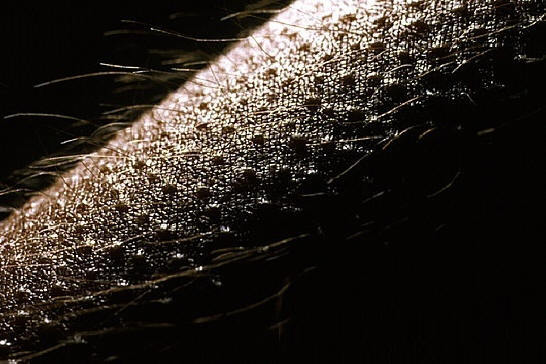FWP:
SETS == GROTESQUERIE
If the little hairs on one's body stand up, in English the convention is that the cause is cold, or else sudden creepy horror. South Asian convention is a bit more elastic: Sanskrit has room for the expression of bliss also (as does Hindi: see pulak and pulkit honā , Platts p.268). Another possibility, relied on by all the commentators but made explicit by Bekhud Dihlavi, is that this reaction happens because of a fever (possibly accompanied by chills?).
If the hairs on the body stand up, they become thin, wavy little things, flexible but firmly anchored at one end. This makes them, for the purposes of the present verse, very like tongues. So if they are waving or wagging tongues, they are surely saying something. Why, of course they are: they're expressing thanks for the boon of the heat or fever of grief.
And even then, the verse implies, they're insufficient: they're already waggling their little tongue-tips off, yet the first line inquires, rhetorically or seriously, 'to what extent' [kahāñ tak] the appropriate thanks might be expressed. The most obvious reading is that all this hair-tongue-waggling is probably still grossly insufficient to the intensity of the joy of it all. Another reading might be that the speaker is expressing impatience with the whole process (compare {214,6}).
Thus, contrary to appearances, the lover is not shivering and writhing with the 'fever' or heat of grief; instead, he's expressing thanks for the joy of such suffering. This is of course parallel to the lover's joy in wounds (see for example {92,5}), and ultimately in death (as in {17,5}).
However, the verse still makes it into my 'grotesquerie' category. The vision of every hair on the body as a tiny tongue constantly waving around expressing feverish thanksgiving is simply distasteful. This verse wants you to somehow stop your imagination from using the 'objective correlative' vision to the fullest. The thought of a body covered with tiny wagging tongues reminds me irresistibly of the story about how Indra's lustful intentions toward a rishi's wife, Ahalya, were punished when he was cursed to sprout lingams-- or yonis, depending on which version of the story you hear-- all over his body. Later these were changed into eyes; no doubt that was an improvement of sorts.
Compare Mir's less grotesque (because more abstract and distanced) use of the 'hairs as tongues' image: M{745,7}.

Nazm:
That is, in the increase of the heat/fever of grief, when the hair stands on end, it becomes a tongue of praise/thanksgiving. When it comes to tak and talak , modern poets have rejected talak and adopted tak , but from looking at the poetry of the older poets it can be seen that the words tak and talak are both discovered. (150)
== Nazm page 150